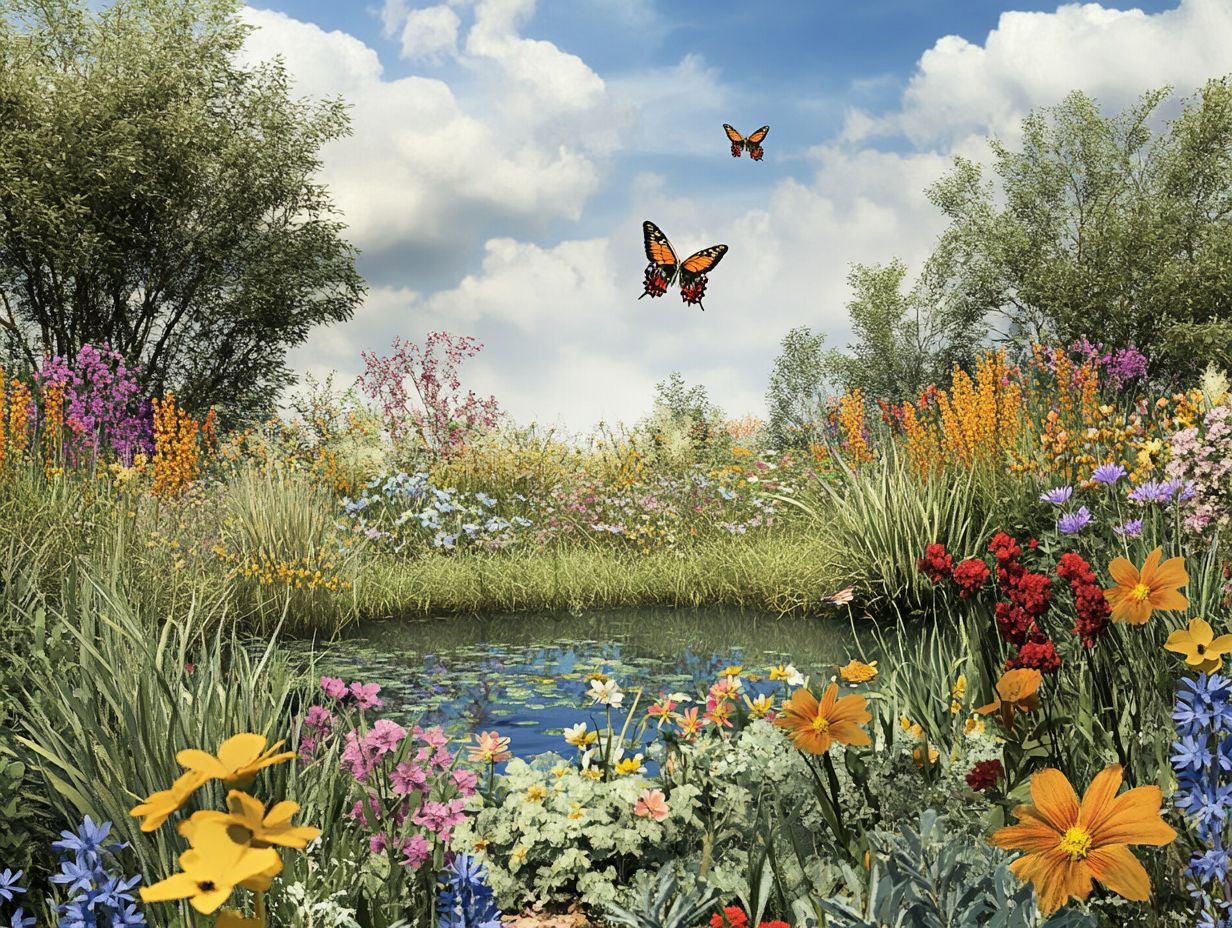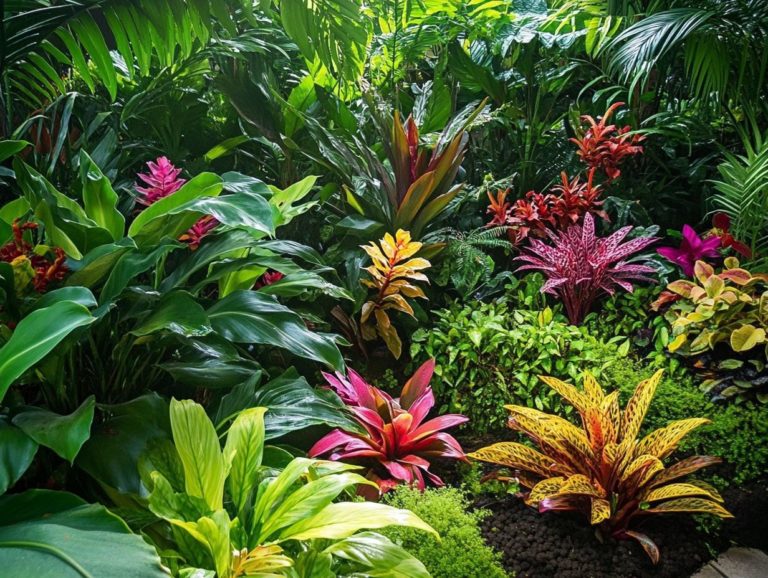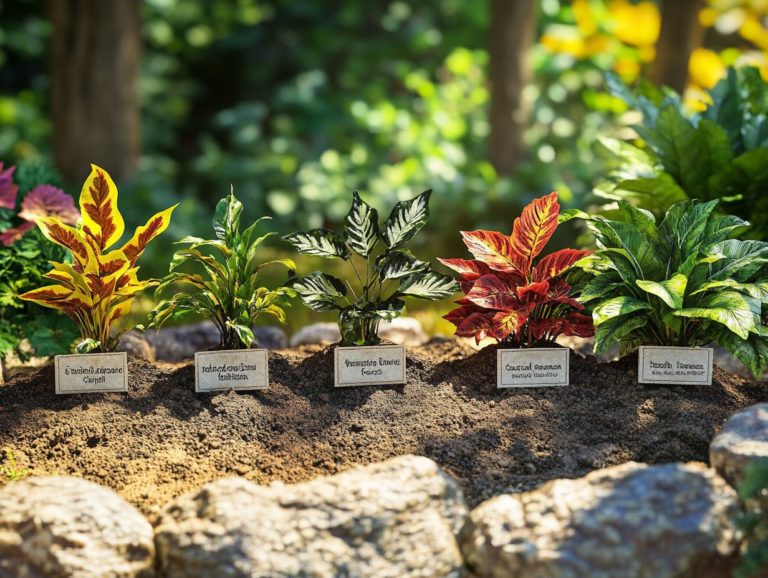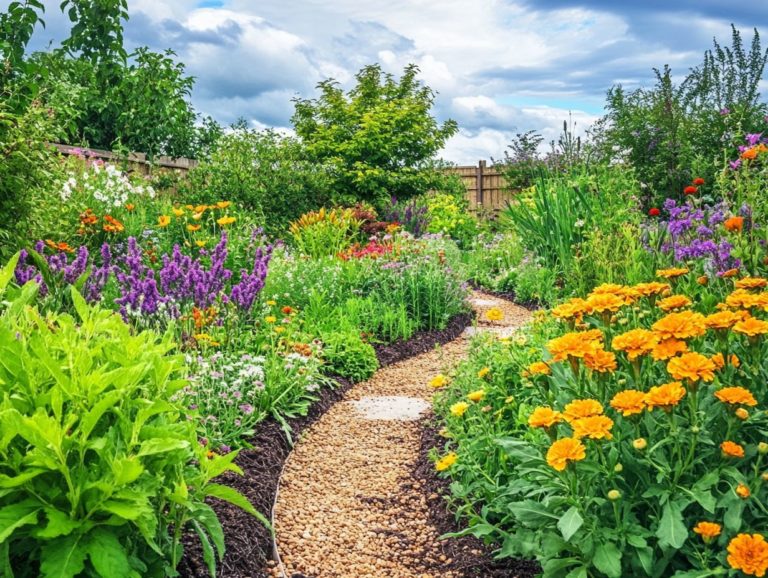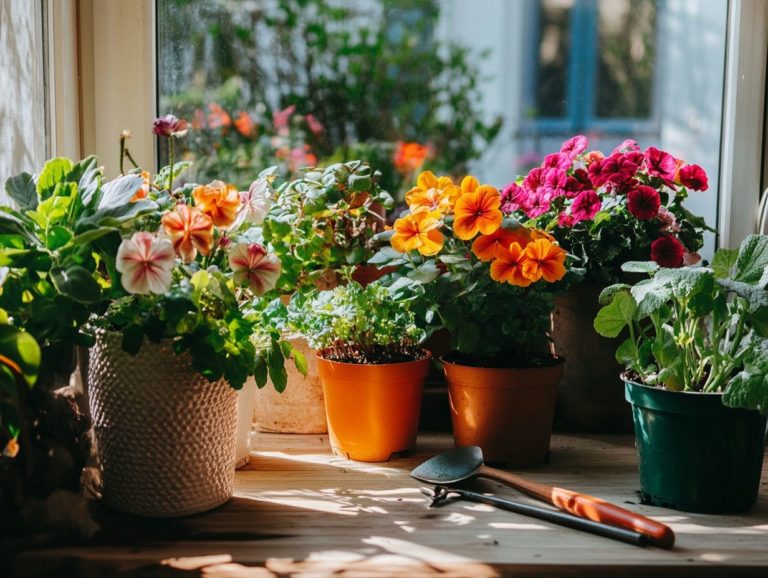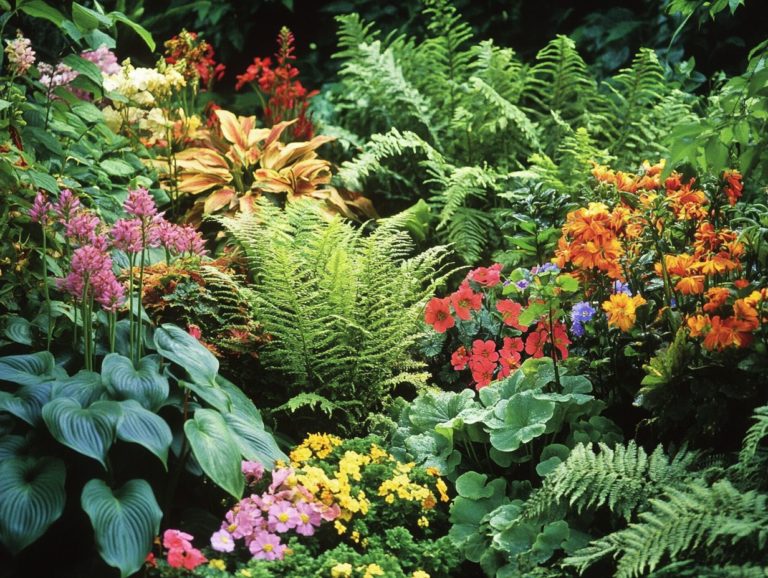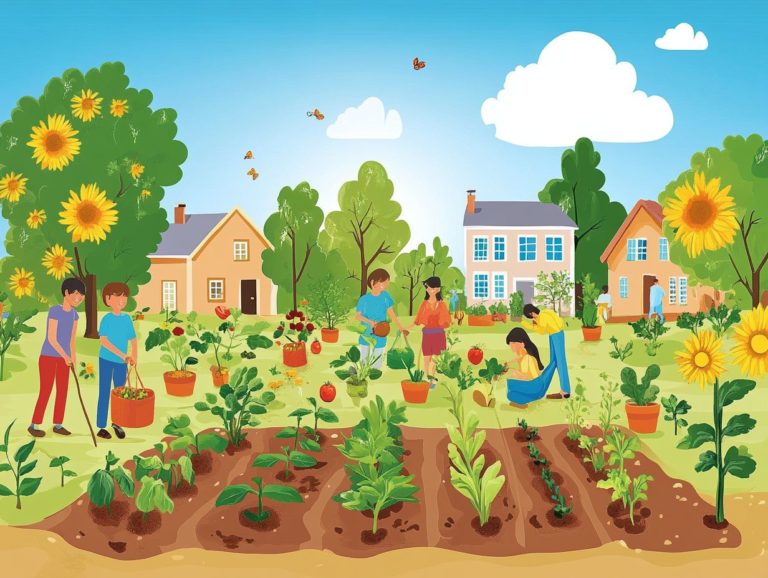“Selecting Plants for a Naturalized Landscape”
Creating a naturalized landscape that thrives in harmony with your environment is both an art and a science.
From understanding your local climate and soil conditions to selecting local plants that support wildlife, every decision you make shapes the beauty and resilience of your garden.
Get ready to explore vital tips for designing a stunning and eco-friendly landscape! Whether you’re aiming for year-round interest or looking to attract pollinators, you’ll find practical tips to help you cultivate a flourishing outdoor space.
Dive in and discover how to make thoughtful choices that enhance both aesthetics and ecology!
Contents
- Key Takeaways:
- 1. Consider Your Climate and Soil Conditions
- 2. Choose Local Plants
- 3. Include a Diversity of Plants
- 4. Plan for Year-Round Interest
- 5. Consider the Growth Habits of Plants
- 6. Think About Maintenance Requirements
- 7. Create a Balanced Ecosystem
- 8. Incorporate Plants with Different Heights
- 9. Choose Plants That Attract Wildlife
- 10. Consider the Color Palette of Your Landscape
- 11. Plan for Different Blooming Seasons
- 12. Incorporate Plants That Have Multiple Functions
- 13. Consider the Aesthetics of Your Landscape
- 14. Think About the Purpose of Your Landscape
- 15. Seek Professional Advice
- Frequently Asked Questions
- What is a naturalized landscape?
- How can I create a thriving garden?
- What plants are best for attracting wildlife?
- Can I mix edible and ornamental plants?
- Why should I select plants for a naturalized landscape?
- What factors should I consider when selecting plants?
- How do I choose the right plants?
- What are some popular native plant options?
- Can I use non-native plants in my landscape?
Key Takeaways:
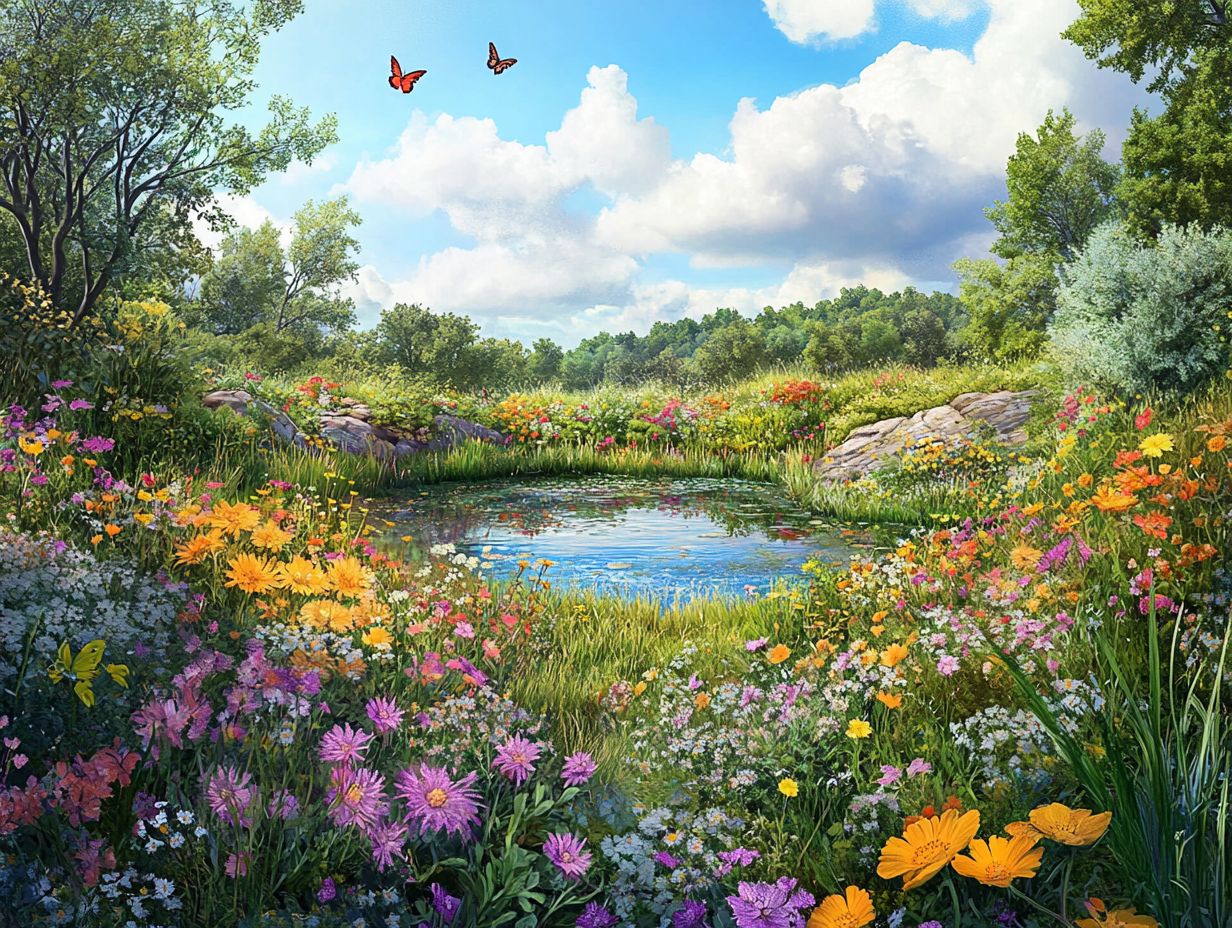
- Choose local plants that can thrive in your climate and soil conditions.
- Incorporate a variety of plant types for a balanced and diverse landscape.
- Plan for year-round interest by selecting plants with different blooming seasons and growth habits.
1. Consider Your Climate and Soil Conditions
Understanding your local climate and soil conditions is essential for crafting an effective landscape design. This knowledge directly helps you choose local plants and their ability to flourish in specific environments. By choosing the right plant for the right place, you ll cultivate a garden oasis that not only thrives but also reflects your unique aesthetic appeal.
Climate plays a pivotal role in determining which plants will flourish, how they grow, and when they bloom. For example, if you re in a region that experiences heavy rainfall, you’ll want to consider plants that can handle excess moisture. On the other hand, if you find yourself in arid areas, selecting drought-resistant varieties becomes crucial.
It’s also important to understand drainage issues. Poor drainage can lead to root rot and other complications, undermining the success of your beautiful garden designs.
Evaluating soil types gives you valuable insights into nutrient availability and pH levels (the acidity or alkalinity of the soil), both of which directly impact plant vitality. By considering these factors, you can create a harmonious landscape that thrives naturally, enriching both your outdoor space and your spirit.
2. Choose Local Plants
Choosing local plants is a crucial aspect of eco-friendly gardening. These species are perfectly suited to your local environment, enhancing variety of plants and animals and supporting wildlife habitats, which ultimately enriches the ecological systems of your landscape.
Along with their ecological advantages, local plants come with impressive perks. They require minimal maintenance and possess a natural resistance to local pests and diseases. This means you can water less frequently and reduce your reliance on chemicals, fostering a more sustainable gardening approach.
Local nurseries typically offer a diverse selection of local species that align beautifully with the unique climate and soil conditions of your area. This makes it easier for you to select plants that will not only thrive but do so with minimal effort.
3. Include a Diversity of Plants
Incorporating a variety of plant types is essential for achieving landscape diversity. This approach not only elevates the aesthetic appeal of your garden design but also promotes ecological balance through companion planting strategies and varied growth patterns.
This diversity can significantly enhance natural pest management, as different plants attract beneficial insects that keep harmful pests at bay, thus minimizing the need for chemical interventions.
A mixed planting scheme fosters healthier soil, with varying root structures improving aeration and nutrient uptake. As different species bloom throughout the year, they provide seasonal interest, creating a dynamic and colorful environment that captivates the senses and supports a wide range of wildlife.
By nurturing a rich tapestry of flora, you can cultivate resilient ecosystems that thrive year-round, all while enjoying the aesthetic and practical benefits of a varied landscape.
4. Plan for Year-Round Interest
To create a visually striking garden, you must plan for year-round interest by selecting plants that bloom across the seasons. This strategy makes your garden look better and ensures ornamental appeal even during off-peak times.
By thoughtfully incorporating a mix of perennials, annuals, and shrubs that flower at various intervals, you can keep your garden vibrant throughout the year. Don t overlook the foliage and berries of these plants; they provide essential texture and color when blooms are absent. Varieties with colorful leaves can add remarkable depth, while berries introduce seasonal hues that attract wildlife.
This approach not only elevates your garden’s aesthetic but also fosters a dynamic environment, making each visit feel fresh and engaging.
5. Consider the Growth Habits of Plants
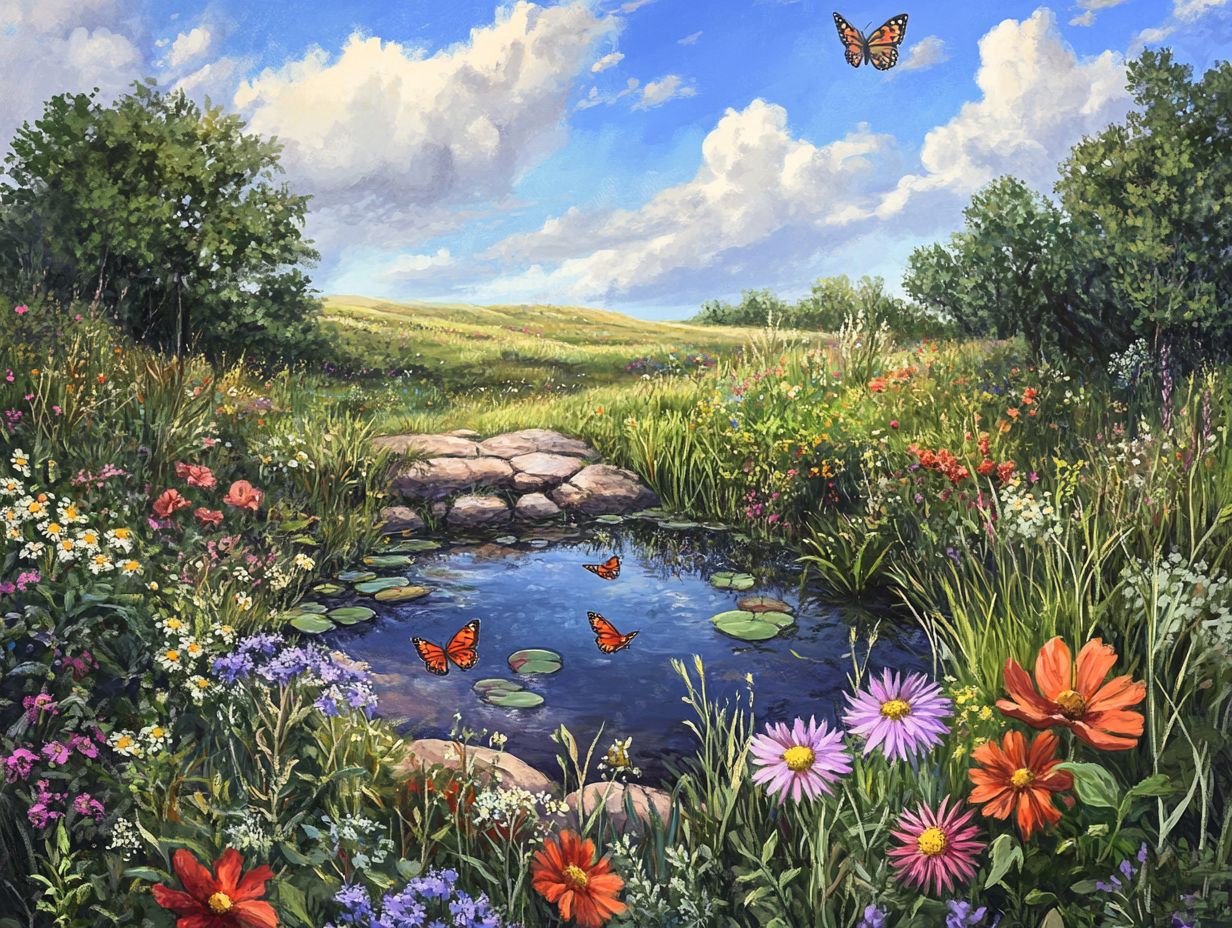
Understanding the growth habits of plants is essential for managing your garden. This knowledge empowers you to make informed decisions about spacing, pruning techniques, and the overall layout of your garden, ensuring that each plant thrives in its designated environment without the stress of competing for resources.
Different species exhibit unique growth rates and patterns, which can significantly influence their placement within your landscape. For example, fast-growing plants may quickly overshadow their slower-growing neighbors, making careful planning imperative to maintain balance and aesthetic appeal.
Paying attention to moisture levels and sunlight exposure is crucial, as these factors dictate a plant’s health, vitality, and overall appearance. Some species flourish in dry, sunny spots, while others thrive in shadier, more humid environments.
By considering these variables, you can create a harmonious garden that not only showcases the beauty of each species but also maximizes their potential.
6. Think About Maintenance Requirements
When planning your landscape, it s crucial to consider maintenance requirements. Opting for low-maintenance plants can significantly minimize the time and effort you spend on plant care while keeping your garden healthy and visually stunning.
Understanding the specific maintenance needs of these plants goes beyond simply watering and feeding. It involves mastering the right pruning techniques to encourage growth and prevent overcrowding, as well as being proactive with pest management strategies to ward off unwanted intruders.
By recognizing the seasonal upkeep required for each type of plant, you can foster a thriving ecosystem in your garden. Committing to these maintenance practices enhances the beauty of your space and contributes to the long-term sustainability of your landscape.
7. Create a Balanced Ecosystem
Creating a balanced ecosystem in your garden is all about the relationships between plants, soil, and wildlife. This understanding empowers you to design a landscape that not only fosters biodiversity but also supports local fauna and enhances the overall health of your ecological systems.
To achieve this balance, selecting the right mix of plants is paramount. Incorporating native species adapts beautifully to local conditions while providing essential habitats and food for various wildlife. By choosing pollinator-friendly plants, you ll attract bees, butterflies, and other vital pollinators, elevating the productivity of your garden and the surrounding nature.
Effective landscape management practices like minimizing chemical use and embracing organic gardening techniques can further solidify these ecological principles. This approach supports soil health and promotes a sustainable environment. By thoughtfully integrating these elements, you can cultivate a thriving space that harmonizes beautifully with nature. Act now to support local wildlife and enjoy a vibrant garden!
8. Incorporate Plants with Different Heights
Incorporating plants of varying heights into your landscape design creates a captivating visual experience, adding depth and dimension that elevates your garden’s aesthetic appeal. This thoughtful layering not only enhances the beauty of your outdoor space but also nurtures diverse microclimates, catering to various plant species.
For instance, consider how taller trees like oaks or maples provide essential shade for the understory plants. Medium-sized shrubs, such as azaleas and hydrangeas, thrive beautifully in that protective environment. Meanwhile, ground covers like creeping thyme or ferns flourish in the dappled sunlight filtering through the canopy, fostering a harmonious ecosystem.
This thoughtful mix creates a vibrant, dynamic outdoor space that you can truly appreciate.
9. Choose Plants That Attract Wildlife
Choosing plants that attract wildlife not only enhances your garden’s beauty but also cultivates a lively habitat for various species, benefiting the ecosystem while elevating your landscape’s ecological charm.
By selecting native flowers, fruits, and shrubs, you can invite an array of beneficial wildlife into your garden think lively pollinators like bees and butterflies, as well as the delightful songs of different birds. Planting diverse species encourages a balanced ecosystem, allowing for natural pest control through predatory insects that thrive on harmful pests.
For instance, attracting ladybugs and lacewings known for their insatiable appetite for aphids can significantly diminish pest populations without resorting to chemical solutions. These intentional plant choices not only offer vital food and shelter but also nurture a harmonious relationship with nature, fostering a sustainable environment that bolsters the overall health of your garden.
10. Consider the Color Palette of Your Landscape
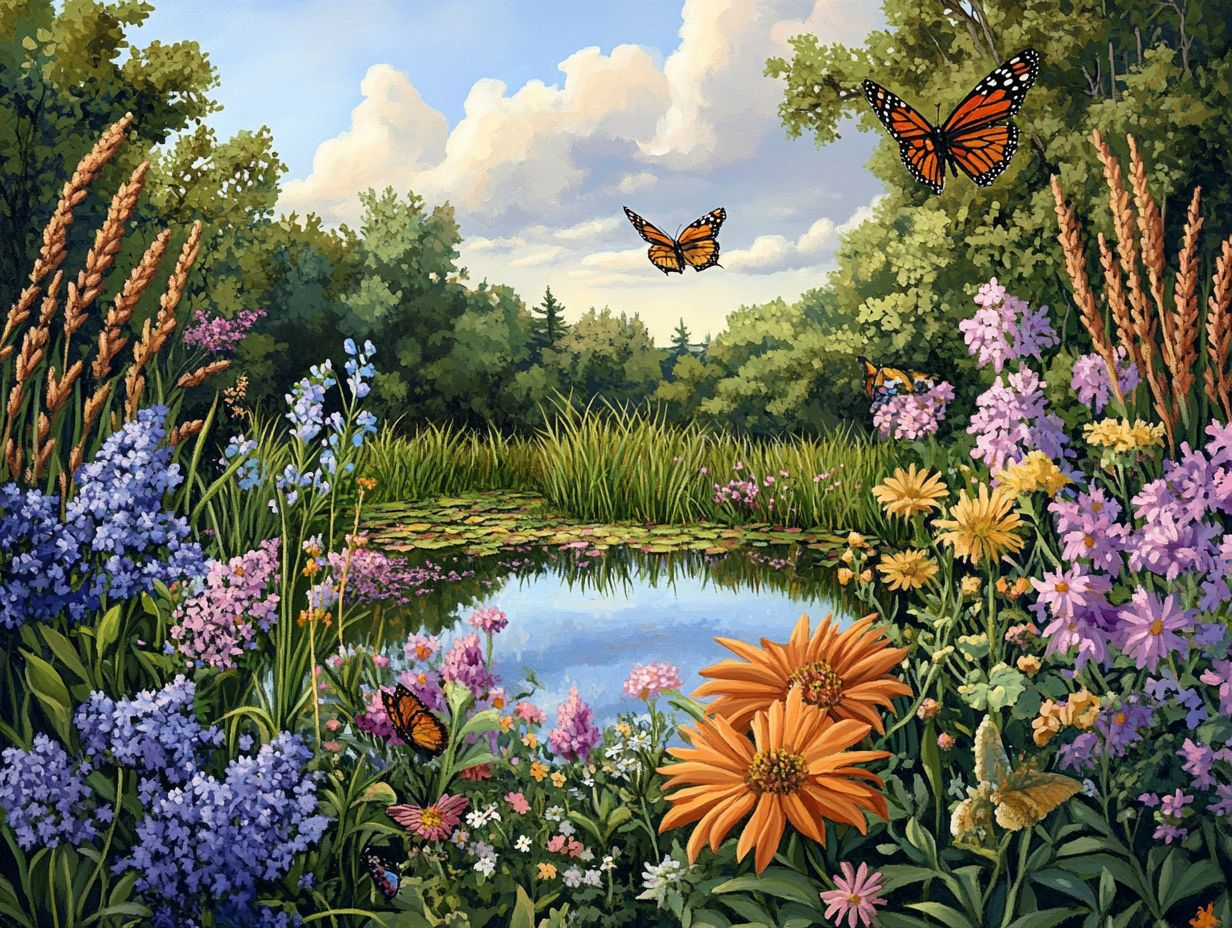
The color palette of your landscape is important in shaping its overall aesthetic appeal. By thoughtfully selecting plants that complement one another, you can craft a visually harmonious garden that evolves beautifully with the seasons.
Understanding color theory the study of how colors work together is essential for anyone eager to elevate their outdoor spaces. It gives you the power to choose colors that not only work well together but also create intentional contrasts that draw the eye. For example, pairing warm-toned flowers like reds and yellows with cooler greens can infuse your garden with a lively atmosphere. Being aware of how seasonal changes influence the landscape allows you to select plants that offer a diverse array of colors throughout the year.
This foresight ensures there s always something exciting to see, whether it s the bright blooms of spring or the rich hues of autumn, enriching your garden experience no matter the season.
11. Plan for Different Blooming Seasons
Planning for different blooming seasons allows your landscape to maintain a vibrant allure year-round, offering you the pleasure of continuous seasonal interest while thoughtfully selecting plants based on their flowering times.
Incorporating a diverse array of plants that bloom at various intervals creates a stunning tapestry of colors and textures. This layering of blooms not only enhances visual appeal but also supports local ecosystems, inviting pollinators and beneficial insects into your garden throughout the seasons.
Consider this: daffodils burst into bloom in early spring, soon followed by the vibrant tulips and flowering bulbs that encapsulate the season’s spirit. As summer rolls in, coneflowers and daisies add splashes of brightness, while autumn showcases the brilliance of asters and chrysanthemums.
Each species you choose contributes uniquely to your landscape, offering not just aesthetic beauty but also structural variety in your garden designs.
12. Incorporate Plants That Have Multiple Functions
Using multifunctional plants makes your landscape more practical. It also enhances sustainability. These plants can serve as food sources, attract beneficial wildlife, and promote soil health by planting different types of plants together.
For example, when you plant native wildflowers, you’re not just adding beauty to your garden; you re also inviting essential pollinators like bees and butterflies. They play a vital role in maintaining healthy ecosystems. By growing edible plants such as herbs and vegetables alongside plants that help improve soil health, you enhance soil quality by enriching it with necessary nutrients.
Consider adding perennials like asparagus or berry bushes. They provide long-term food sources while minimizing the need for replanting. Embracing sustainable gardening principles encourages the use of diverse plant species. This fosters resilience in your garden and reduces reliance on chemical fertilizers or pesticides.
13. Consider the Aesthetics of Your Landscape
Aesthetics are paramount in landscape design. The visual allure of your garden can elevate your outdoor experience and significantly boost your property s value. With a thoughtful selection and arrangement of plants, you can create a stunning ornamental beauty that captivates the senses throughout the seasons.
By carefully considering the interplay of color, texture, and form, you can establish a cohesive and inviting atmosphere. Utilizing a diverse palette that mirrors the natural surroundings not only injects vibrancy but also fosters harmony among various plant species.
Being mindful of how seasonal changes influence your garden s appearance allows you to incorporate plants that offer year-round interest, such as evergreens and perennials. This approach keeps your landscape charming even in winter, transforming your garden into an aesthetically pleasing retreat, no matter the season.
14. Think About the Purpose of Your Landscape
Defining the purpose of your landscape is crucial for achieving effective garden design. Whether you re aiming to create a serene garden oasis, an urban gardening space, or a vibrant wildlife habitat, your goals will guide your plant selection and layout.
By contemplating your vision for the space, you can make choices that enhance both the practicality and visual appeal of your garden. For instance, if your goal is to cultivate a cozy retreat, opting for softer, flowering plants of varying heights can add depth. On the other hand, if your focus is on food production, you ll want resilient, nutritious plants strategically placed to maximize sunlight and ensure proper drainage.
Understanding these distinct purposes elevates the functionality of your landscape and enriches its aesthetic quality. This creates an environment that is genuinely inviting and perfectly aligned with your vision.
15. Seek Professional Advice
Seeking professional advice can truly elevate your gardening experience! It offers insights into effective landscape management, optimal plant selection, and tailored planting practices that perfectly suit your unique site conditions.
When you consult with landscape professionals, garden centers, and local nurseries, you unlock a treasure trove of knowledge that goes well beyond the basics. These experts provide guidance on soil health, pest management, and seasonal planting strategies tailored to your climate and the distinctive characteristics of your property.
Their customized recommendations can help you sidestep common gardening pitfalls. This ensures your efforts yield thriving plants and a vibrant garden environment. This collaboration not only promotes healthy ecosystems but also cultivates a sense of community as you connect with local resources dedicated to nurturing your gardening journey.
Frequently Asked Questions
What is a naturalized landscape?
A naturalized landscape is an area that has been intentionally designed to mimic a natural environment. It often uses native plants to promote biodiversity and create a more sustainable, low-maintenance landscape.
How can I create a thriving garden?
To create a thriving garden, start by defining your goals, choosing the right plants, and consulting with local experts. Regular maintenance and seasonal care are also essential for success!
What plants are best for attracting wildlife?
Plants such as native wildflowers, berry bushes, and various herbs can attract wildlife to your garden. They provide food and habitat for birds, insects, and other beneficial creatures.
Can I mix edible and ornamental plants?
Absolutely! Mixing edible and ornamental plants can enhance the beauty of your garden while providing delicious harvests. It’s a great way to maximize both aesthetics and functionality.
Ready to transform your garden? Start your gardening journey today or consult a local expert for personalized advice!
Why should I select plants for a naturalized landscape?
Choosing the right plants makes your landscape look good and helps the local ecosystem. It also saves you time and resources.
What factors should I consider when selecting plants?
Consider the climate, soil, water availability, and sunlight. Think about what you want your landscape to achieve.
How do I choose the right plants?
Research native plants suited for your location. Local experts and online resources can guide your choices.
What are some popular native plant options?
Popular choices include wildflowers, grasses, shrubs, and trees like purple coneflower and eastern red cedar. These plants attract wildlife and enhance visual appeal.
Can I use non-native plants in my landscape?
You can include a few non-native plants, but research their impact first. Choose non-invasive species to protect the ecosystem.

